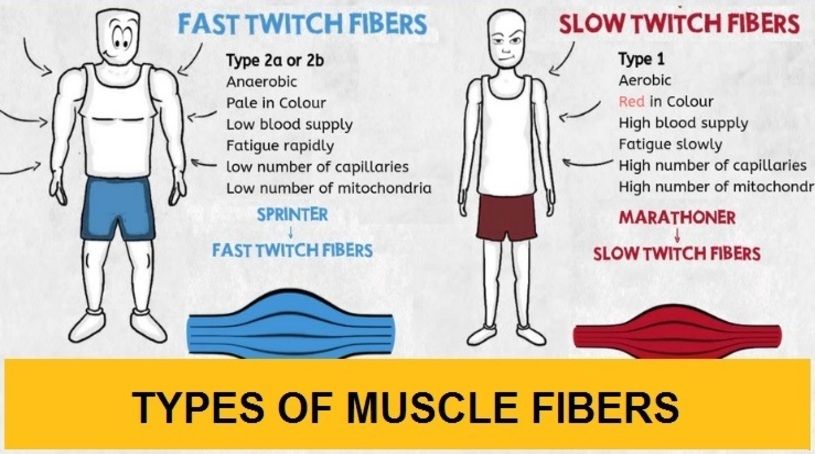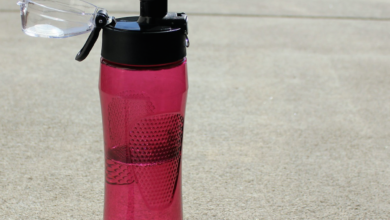
The Best Way to Train Slow and Fast Twitch Muscles
The best way to train slow and fast twitch muscles is by understanding the distinct roles these fibers play in our bodies. Slow twitch muscle fibers are endurance champions, powering us through long runs and swims, while fast twitch fibers unleash explosive power for sprints and heavy lifting.
This knowledge is crucial for tailoring workouts to achieve specific fitness goals.
Whether you’re aiming for a marathon finish line or a personal best in the gym, understanding how to train these muscle fibers is essential. We’ll delve into training strategies, explore the benefits of combining slow and fast twitch training, and discuss considerations for optimal results.
Get ready to unlock your full athletic potential!
Understanding Slow and Fast Twitch Muscle Fibers

Understanding the different types of muscle fibers is crucial for optimizing training and maximizing athletic performance. Our muscles are made up of two primary types of fibers: slow twitch and fast twitch. Each type plays a distinct role in movement, and understanding their characteristics is essential for designing effective training programs.
Slow Twitch Muscle Fibers
Slow twitch muscle fibers, also known as Type I fibers, are specialized for endurance activities. They are characterized by their ability to contract slowly and sustain contractions for extended periods. This makes them ideal for activities like long-distance running, cycling, and swimming.
- High Oxidative Capacity:Slow twitch fibers have a high density of mitochondria, the powerhouses of cells, allowing them to generate energy efficiently through aerobic metabolism. This process uses oxygen to break down carbohydrates and fats, producing a steady supply of ATP, the energy currency of cells.
Training both slow and fast twitch muscle fibers is crucial for overall fitness. While intense bursts of activity engage fast twitch fibers, sustained effort targets slow twitch muscles, which are essential for endurance. However, getting enough sleep is vital for muscle recovery and repair, and studies link poor sleep with cardiovascular disease , impacting our ability to exercise effectively.
Prioritizing sleep, alongside a balanced workout routine, ensures optimal muscle development and overall health.
- Rich Capillary Network:Slow twitch fibers are densely surrounded by capillaries, tiny blood vessels that deliver oxygen and nutrients and remove waste products. This efficient blood supply ensures a constant supply of oxygen for aerobic metabolism.
- High Fatigue Resistance:Due to their efficient energy production and excellent blood supply, slow twitch fibers are highly resistant to fatigue. They can sustain contractions for long periods without becoming exhausted.
Fast Twitch Muscle Fibers
Fast twitch muscle fibers, also known as Type II fibers, are designed for power and speed. They contract rapidly and generate high force, making them ideal for activities like sprinting, jumping, and weightlifting.
Balancing slow and fast twitch muscle training is crucial for overall fitness. Slow twitch muscles are responsible for endurance, while fast twitch muscles power explosive movements. A well-rounded routine should include both types of training. For a quick and effective way to strengthen your core, try this your 10 minute no equipment core workout.
Targeting your core muscles strengthens your body’s foundation, improving stability and overall performance, which benefits both slow and fast twitch muscle development.
- Low Oxidative Capacity:Fast twitch fibers have a lower density of mitochondria compared to slow twitch fibers. They primarily rely on anaerobic metabolism, which does not require oxygen. This process breaks down glycogen, a stored form of glucose, to produce ATP quickly but less efficiently.
- Limited Capillary Network:Fast twitch fibers have a less extensive capillary network than slow twitch fibers. This means they receive less oxygen and nutrients and have a lower capacity for sustained activity.
- High Fatigue Rate:Fast twitch fibers are prone to fatigue because they rely on anaerobic metabolism, which produces lactic acid, a byproduct that can impair muscle function.
Examples of Activities
- Slow Twitch Fiber Activities:Long-distance running, cycling, swimming, cross-country skiing, hiking, rowing.
- Fast Twitch Fiber Activities:Sprinting, jumping, weightlifting, powerlifting, throwing, hitting a baseball.
Energy Systems Used
Slow twitch fibers primarily use aerobic metabolism, which requires oxygen to generate energy. This process is slow but efficient and can sustain activity for long periods. Fast twitch fibers primarily rely on anaerobic metabolism, which does not require oxygen. This process is fast but inefficient and can only sustain activity for short periods.
“Slow twitch fibers are like marathon runners, while fast twitch fibers are like sprinters.”
Training Strategies for Fast Twitch Muscle Fibers

Fast twitch muscle fibers are responsible for explosive power and strength. They are recruited during activities that require short bursts of intense effort, such as sprinting, jumping, and weightlifting. To maximize the development of these fibers, it’s crucial to employ training strategies that specifically target their characteristics.
Resistance Training
Resistance training is paramount for developing fast twitch muscle fibers. By challenging the muscles with heavy loads, you stimulate hypertrophy, the process of muscle growth. This growth primarily occurs in the fast twitch fibers, leading to increased strength and power.
Weightlifting Program
A well-structured weightlifting program is essential for maximizing fast twitch fiber development. The following program incorporates compound exercises known for their effectiveness in stimulating muscle growth:
Exercise Selection
- Squats: This compound exercise targets multiple muscle groups, including the quads, glutes, hamstrings, and core, promoting overall strength and power development.
- Deadlifts: Deadlifts are another compound exercise that engages a wide range of muscles, including the back, legs, and core. They are particularly effective for building strength and power in the lower body.
- Bench Press: This exercise primarily targets the chest, shoulders, and triceps, enhancing upper body strength and power.
Sets and Reps
To stimulate fast twitch fiber growth, focus on weightlifting sets within the 6-12 rep range. This range ensures sufficient muscle stress to trigger hypertrophy while allowing for proper form and technique.
Rest Periods
Adequate rest periods between sets are crucial for muscle recovery and maximizing training benefits. Aim for rest periods of 60-90 seconds between sets, allowing sufficient time for the muscles to replenish energy stores and prepare for the next set.
Plyometric Exercises
Plyometric exercises are explosive movements that involve a rapid stretch-shortening cycle. These exercises enhance explosiveness and power by engaging the fast twitch muscle fibers.
Examples
- Box Jumps: This exercise involves jumping onto a box, requiring explosive power from the legs and core.
- Medicine Ball Throws: Throwing a medicine ball against a wall engages the muscles in a powerful, explosive movement, promoting strength and power development.
- Jump Squats: This variation of the squat involves jumping vertically after each squat, enhancing explosiveness and power.
Nutrition for Fast Twitch Fiber Development
Proper nutrition plays a vital role in supporting fast twitch fiber development. Adequate protein intake is essential for muscle repair and growth, while carbohydrates provide energy for intense workouts.
Protein Intake
Aim for a protein intake of 1.6-2.2 grams per kilogram of body weight daily to support muscle growth and repair. Include lean protein sources like chicken, fish, eggs, and beans in your diet.
Finding the right balance between training your slow and fast twitch muscles is key to overall fitness. Slow twitch muscles are essential for endurance activities like walking, while fast twitch muscles are responsible for explosive movements. The good news is that even if you’ve never exercised before, walking can help you live longer even if you’ve never exercised before , and it’s a great way to engage your slow twitch muscles.
To build both types of muscle, incorporate a variety of exercises like running, swimming, and weight training into your routine.
Carbohydrate Intake
Consume sufficient carbohydrates to provide energy for intense workouts. Opt for complex carbohydrates like whole grains, fruits, and vegetables, which provide sustained energy release.
Considerations for Optimal Training
Maximizing your training results requires a comprehensive approach that goes beyond simply lifting weights or performing exercises. By considering factors like proper warm-up and cool-down routines, adequate rest and recovery, and a balanced diet, you can optimize muscle growth and performance, while also minimizing the risk of injury.
Importance of Proper Warm-Up and Cool-Down Routines
A proper warm-up prepares your body for the demands of exercise by gradually increasing your heart rate, blood flow, and muscle temperature. This helps to improve flexibility, reduce the risk of injury, and enhance athletic performance. A typical warm-up routine might include:
- Light cardio, such as jogging or jumping jacks (5-10 minutes)
- Dynamic stretching, which involves controlled movements through a range of motion (5-10 minutes)
- Specific exercises that target the muscle groups you will be working during your workout (2-3 minutes)
A cool-down routine allows your body to gradually transition from a high-intensity state to a resting state. It helps to reduce muscle soreness, improve flexibility, and promote recovery.A typical cool-down routine might include:
- Light cardio (5-10 minutes)
- Static stretching, which involves holding a stretch for a period of time (5-10 minutes)
Importance of Adequate Rest and Recovery, The best way to train slow and fast twitch muscles
Rest and recovery are crucial for muscle growth and adaptation. During exercise, your muscle fibers experience microscopic tears. These tears are then repaired and rebuilt during the recovery process, resulting in stronger and larger muscles.
- Allowing sufficient time for rest between workouts allows your muscles to repair and rebuild.
- Getting adequate sleep is essential for muscle recovery and growth.
- Active recovery, such as light cardio or stretching, can help to improve blood flow and reduce muscle soreness.
Role of Proper Nutrition in Supporting Muscle Growth and Performance
Nutrition plays a vital role in muscle growth and performance. Consuming a balanced diet that is rich in protein, carbohydrates, and healthy fats provides the necessary nutrients for muscle repair, energy production, and overall health.
- Protein is essential for muscle growth and repair.
- Carbohydrates provide energy for exercise.
- Healthy fats support hormone production and cell function.
Potential Risks and Limitations Associated with Intense Training Programs
While intense training programs can lead to significant muscle growth and performance improvements, they also carry potential risks and limitations.
- Overtraining can lead to injuries, fatigue, and decreased performance.
- Intense training can place a significant stress on your body, potentially leading to hormonal imbalances and other health issues.
- It is important to listen to your body and take rest days when needed.
Closing Summary: The Best Way To Train Slow And Fast Twitch Muscles
By understanding the characteristics of slow and fast twitch muscle fibers and implementing targeted training strategies, you can unlock your body’s full potential. Whether you’re a seasoned athlete or a fitness enthusiast, incorporating both slow and fast twitch training into your routine can lead to significant improvements in endurance, strength, and overall athletic performance.
Remember, consistency, proper nutrition, and adequate rest are crucial for achieving your fitness goals. So, embrace the challenge, listen to your body, and enjoy the journey of unlocking your athletic potential!






